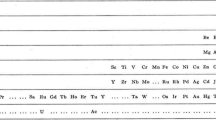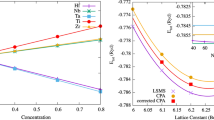Abstract
The electronic structures of elements in the periodic table were analyzed using available experimental ionization energies. Two new parameters were defined to carry out the study. The first parameter—apparent nuclear charge (ANC)—quantified the overall charge of the nucleus and inner electrons observed by an outer electron during the ionization process. This parameter was utilized to define a second parameter, which presented the shielding ability of an electron against the nuclear charge. This second parameter—electron shielding effect (ESE)—provided an insight into the electronic structure of atoms. This article avoids any sort of approximation, interpolation or extrapolation. First experimental ionization energies were used to obtain the two aforementioned parameters. The second parameter (ESE) was then graphed against the electron number of each element, and was used to read the corresponding electronic structure. The ESE showed spikes/peaks at the end of each electronic shell, providing insight into when an electronic shell closes and a new one starts. The electronic structures of elements in the periodic table were mapped using this methodology. These graphs did not show complete agreement with the previously known “Aufbau” filling rule. A new filling rule was suggested based on the present observations. Finally, a new way to organize elements in the periodic table is suggested. Two earlier topics of effective nuclear charge, and shielding factor were also briefly discussed and compared numerically to demonstrate the capability of the new approach.


















Similar content being viewed by others
References
Politzer P, Parr RG (1974) J Chem Phys 61:4258
Politzer P, Murray JS (2002) Theor Chem Accounts 108:134–142
Politzer P (1987) Single-particle density in physics and chemistry. Academic, New York
Politzer P (2003) In: Brandas EJ, Kryachko ES (eds) Fundamental world of quantum chemistry, vol 1. Kluwer, Dordrecht, pp 631–638
Politzer P, Jin P, Jabout AF, Murray JS (2002) Acta Phys Chim Debrec 34–35:349
Hellmann H (1937) Einfuhrung in die Quantenchemie. Deuticke, Leipzig
Feynman RP (1939) Phys Rev 56:340
Hohenberg P, Kohn W (1964) Phys Rev B 136:864
March NH (1982) J Phys Chem 86:2262
Milne EA (1927) Proc Camb Philol Soc 23:794
Zadeh DH, Murray JS, Redfern PC, Politzer P (1991) J Phys Chem 95(20):7702–7709
Zadeh DH, Grodzicki M, Seminario JM, Politzer P (1991) J Phys Chem 95:7699
Zadeh DH, Murray JS, Grodzicki M, Seminario JM, Politzer P (1992) Int J Quantum Chem 42:267–272
Zadeh DH, Murray JS, Grice ME, Politzer P (1993) Int J Quantum Chem 45:15–20
Politzer P, Zadeh DH (1993) J Chem Phys 98(9):7659
Politzer P, Zadeh DH (1994) J Phys Chem 98:1576–1578
Moini S, Puri A, Zadeh DH, Das PC (1995) Mod Phys Lett B 09:45
Zadeh DH, Grice ME, Concha MC, Murray JS, Politzer P (1995) J Comput Chem 16(5):654–658
Orozco M, Luque FJ, Zadeh DH, Gao J (1995) J Chem Phys 102:6145
Gao J, Zadeh DH, Shao L (1995) J Phys Chem 99(44):16460–16467
Gao J, Pavelites JJ, Zadeh DH (1996) J Phys Chem 100(7):2689–2697
Politzer P, Concha MC, Grice ME, Murray JS, Lane P, Zadeh DH (1998) J Mol Struct (THEOCHEM) 452:75–83
Cotton FA, Wilkinson G (1988) Advanced inorganic chemistry, 5th edn. Wiley, New York
McNaught AD, Wilkinson A (1997) IUPAC. Compendium of chemical terminology—the Gold Book, 2nd edn. Blackwell, Oxford
Kramida A, Ralchenko Yu, Reader J, NIST ASD Team (2014) NIST Ionization Energy Database NIST Atomic Spectra Database (ver. 5.2), National Institute of Standards and Technology, Gaithersburg, MD. https://physics.nist.gov/asd. Accessed 9 August 2017
Lakhtakia A, Salpeter EE (1996) Models and Modelers of Hydrogen. Am J Phys World Sci 65(9):933
Hehre WJ, Radom L, Schleyer PVR, Pople JA (1986) Ab initio molecular orbital theory. Wiley, New York, pp 5–42
Szabo A, Ostlund NS (1989) Modern quantum chemistry. McGraw-Hill, New York, pp 39–70
Pauling L (1932) The nature of the chemical bond. IV. The energy of single bonds and the relative electronegativity of atoms. J Am Chem Soc 54(9):3570–3582
Pauling L (1960) Nature of the chemical bond. Cornell University Press, New York, pp 88–107
Mulliken RS (1934) A new electroaffinity scale; together with data on valence states and on valence ionization potentials and electron affinities. J Chem Phys 2(11):782–793
Mulliken RS (1935) Electronic structures of molecules XI. Electroaffinity, molecular orbitals and dipole moments. J Chem Phys 3(9):573–585
Slater JC (1930) Atomic shielding constants. Phys Rev 36(1):57–64
Clementi E, Raimondi DL (1963) Atomic screening constants from SCF functions. J Chem Phys 38(11):2686–2689
Clementi E, Raimondi DL, Reinhardt WP (1967) Atomic screening constants from SCF functions. II. Atoms with 37 to 86 electrons. J Chem Phys 47(4):1300–1307
Author information
Authors and Affiliations
Corresponding author
Additional information
This paper has been submitted in honor of Prof. Peter Politzer
This paper belongs to Topical Collection P. Politzer 80th Birthday Festschrift
Rights and permissions
About this article
Cite this article
Zadeh, D.H. Electronic structures of elements according to ionization energies. J Mol Model 23, 357 (2017). https://doi.org/10.1007/s00894-017-3534-2
Received:
Accepted:
Published:
DOI: https://doi.org/10.1007/s00894-017-3534-2




